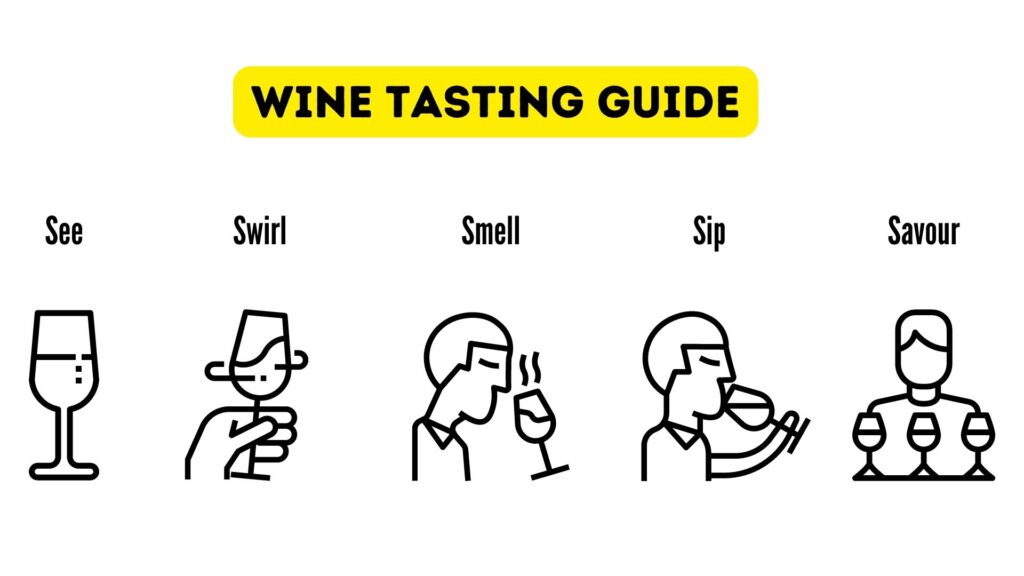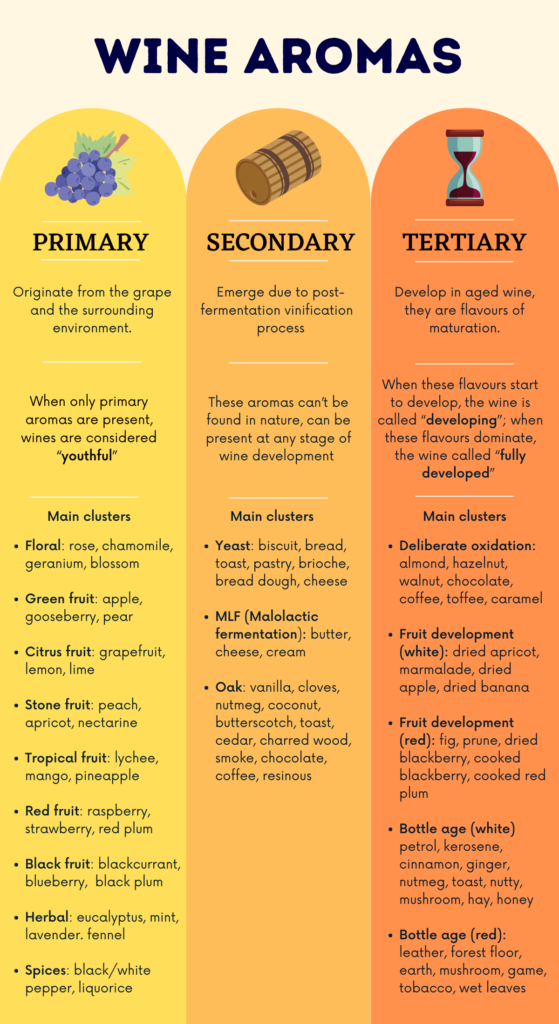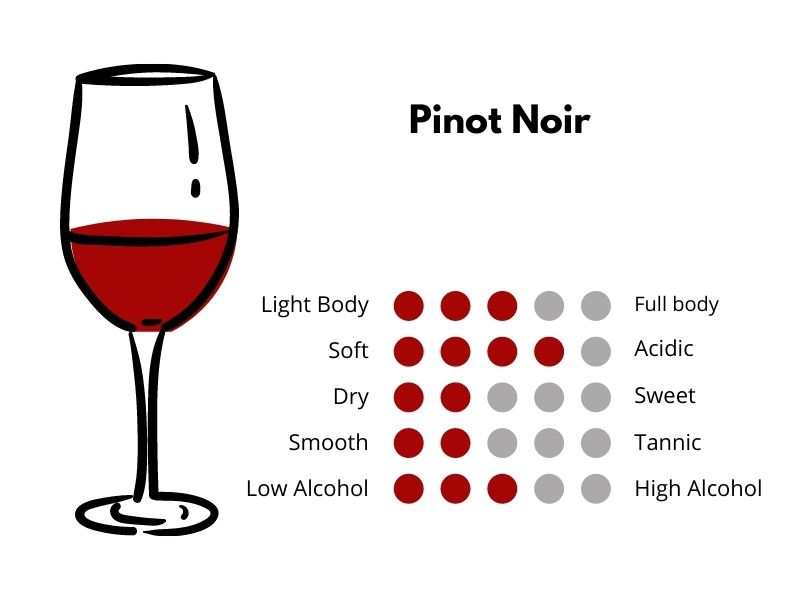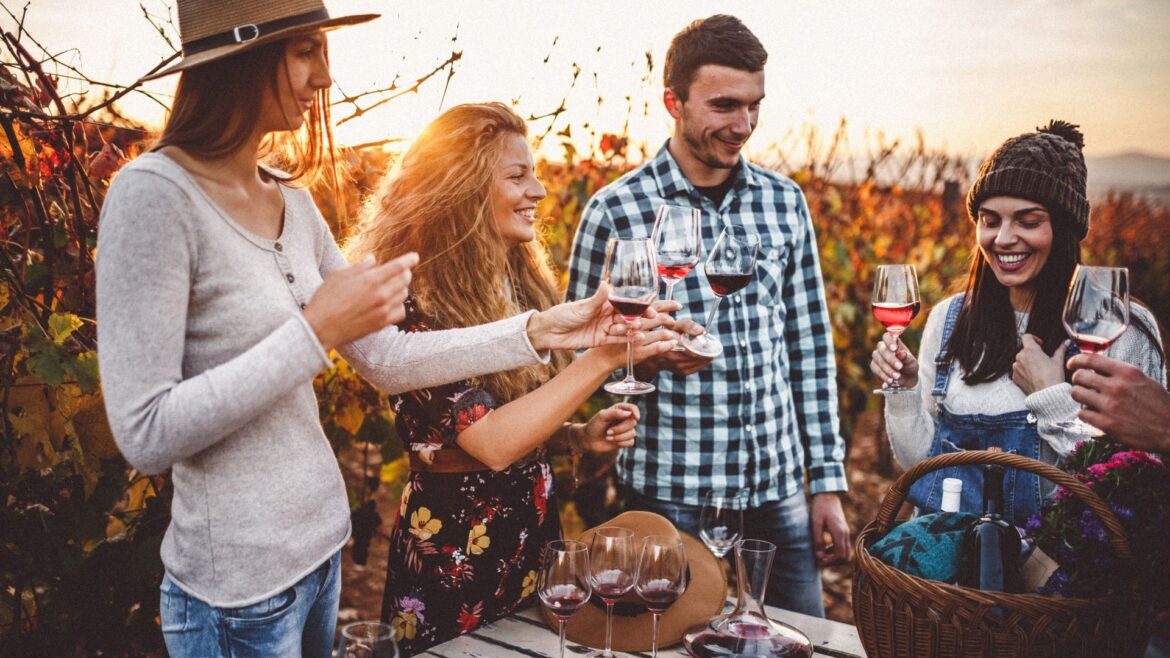In continuation of “The Ultimate Basic Guide For All” where we explored wine basics, categories, and characteristics, this “Wine Tasting Guide” will be an excellent resource for learning about many types of wines and the renowned grapes they are composed of. Furthermore, even if you are a novice, you will grasp how to taste wines like an expert after this guide.
Wine isn’t easy, right? And why bother delving so deeply into the study when all you want is to have fun? True, but the goal of understanding your wine isn’t to learn or go deeper; it’s about raising your level of awareness, which can only enhance your experience and make wines genuinely pleasurable and as they should be!
So, let’s get started!
WINE TASTING GUIDE
Most people find wine tasting to be intimidating. And let me tell you, no wine tastes the same to everyone! Yes, you heard me correctly.
Wine is complicated, as are our senses, which are instruments that help us determine whether we enjoy a wine or not. So it’s not surprising if someone else has a different taste than you. Your brain can only detect odours that are in your memory, which means they are scents you’ve smelled before or frequently. If I may say so, I believe wine reveals more about your preferences than you about wines. All the more reasons to love wine, isn’t it?
5S of Wine Tasting
The fundamentals of wine tasting may be summed up in five words – See, Swirl, Smell, Sip, and Savour

SEE
Wine tasting begins even before you taste it! Strange, but it is true.
To look at the wine is to get a sense of its appearance. The colour and its intensity can reveal a lot about the wine. Gazing the colour of wine in your glass against a white background or against the light is a good place to start.
The colour of a wine comes from contact with the grape skins after the grapes have been juiced. The longer the wine is in contact with the skins, the more colour is imparted to the wine. This is especially true for red wines, while white wines have minimal contact with grape skins, giving them a white to yellow colour.
Oak is also a significant contributor to colour. Ageing in oak barrels can lighten or darken the colour of the wine while also contributing to the overall texture. So learning about colour is a fantastic place to start when learning about wine.
WHITE WINE – White wines come in a variety of yellow hues. They can be clear, light, bright, or deep yellow and full. White wines that are light have had little contact with the grape skins and are generally crisp and refreshing. These wines have often not been matured in oak barrels. If the wine is darker in colour, it was most likely aged in an oak barrel. It will also taste smoother and have a much fuller flavour.
RED WINE – The same applies when assessing a red wine. The lighter the colour of a wine, the more crisp and fresh it will taste, and the less likely it will have been aged in oak. The red wine will become bolder and richer as the colour darkens, nearing maroon and purple hues. The darker and deeper the colour, the longer they’ve been aged in oak barrels.
ROSÉ – A highly pink rosé is likely to be fruitier than one that is light pink, salmon, or orange in colour.
SWIRL
Swirling the wine is not done for show but serves several purposes.
For starters, it helps to perceive the colour more clearly. As the wine swirls and climbs the edges of the glass, it creates a colour gradient that lets you observe the hues through the wine.
Second, the thickness or viscosity of the wine may be gauged by the way it swirls. Wines with a higher alcohol content will begin to form legs or “tears” more easily. As would wine with a higher concentration of heavier molecules, such as tannins and sugar, which explains why tears are more common in rich reds and/or sweet wines.
The third is aeration which leads to evaporation and oxidation. Evaporation disperses some of the original unpleasant odour, improving the wine’s aroma. Allowing a small amount of the alcohol to evaporate helps you smell the wine rather than simply the alcohol.

Aeration allows the wine to oxidize as well. Increased oxidation appears to soften the tannins and smooth out the wine. In a way, it accelerates the wine’s ageing process. However, it should not be aerated for too long because excessive exposure can evaporate the alcohol and flatten out the flavours.
Lastly, swirling concentrates the fragrances above the surface of the wine in the glass, releasing all of the wine’s aromas considerably more than if you don’t.
The technique for swirling the glass varies, but the basic strategy is to do it with glass tabled or while holding it in the air, but not too quickly that it spills. Wine can be swirled for as little as a few seconds or as long as a minute.
SMELL
We receive the first impression of wine when we smell it as we bring the glass up to our noses. When you smell the wine, the alcohol evaporates into the air, bringing lighter-than-air fragrance molecules into your nose. Each wine has hundreds of distinct aroma compounds, and each component influences the flavour of the wine.
After you’ve taken a few brief sniffs of the wine, attempt to focus on the aroma to better comprehend the wine’s qualities. It’s interesting to name all the fruits, flowers, herbs, and other aromas you may recognize in the wine, but it’s not required to do so to enjoy tasting wine.

SIP
Finally, it’s time to drink some wine! Our tongue can detect sweet, salt, bitter, sour, and umami flavours.
So, what flavours can you expect? Wines are frequently viewed as sour due to the acidic quality provided by grapes. Sweetness in wines occurs when grape sugar is retained and can be detected on the tip of the tongue. Some wines are noted for their bitterness (Pinot Grigio), which appears as a mild, pleasant tonic-water-like flavour.
Our tongues can also sense the texture of the wine. Higher alcohol concentrations can add body and texture. The presence of a drying sensation in the mouth suggests that the tannin content is high.
The best way to really appreciate wine is to take a sip and roll it around your mouth. Allow the wine to sit on your tongue for a bit while tasting it. Consider the first impression the wine makes on your tongue, followed by a deluge of flavours and textures.
SAVOUR
The last step in tasting is to swallow and savour the wine. The sensation you receive after swallowing the wine may differ dramatically from the taste you get on your tongue.
The “finish,” or the aftertaste, is a measure of how long the wine taste lingers after the wine is consumed. It is used to determine the wine’s quality. Great wines have lengthy, rich finishes, and particularly excellent wines can be experienced for up to twenty minutes on the palate. The longevity of a flavour profile distinguishes some wines as world-class over others.
Before moving on to the next wine, the final step is to cleanse your palate. Professionals usually eat simple bread or crackers and wash them down with plain water.
I’m sure that with your newfound wine tasting expertise through our wine tasting guide, the world of wine has become even more intriguing, and you can’t wait to try your next bottle. To give you a head start on the experience, let me tell you a bit about some of the well-known grapes that produce excellent wines.
WINE GRAPES
There are literally tens of thousands of different types of wine grapes, yet only a few dozen have gained broad recognition and praise. To get a strong start recognizing great wine, familiarizing yourself with only a few will offer you a tremendous advantage while traversing a wine list or a wine store.

Red Wine Grapes
1. Pinot Noir (Pee-no Nwar)

Pinot Noir is fruit-forward, and tastes include cherry, raspberry, mushroom, forest floor, and vanilla and baking spice when aged in French oak.
Pinot noir grapes are widely regarded for producing some of the world’s most outstanding wines, yet they are one of the most challenging grapes to nurture and transform into wine. But wine enthusiasts are willing to pay extra for its subtle red berry flavours. This red wine grape is the only one permitted in Burgundy, France’s famous red wine. Apart from Burgundy, Pinot Noir is extensively planted in Champagne for sparkling wines, so much so that Champagne has more Pinot Noir vineyards than Burgundy.
Interesting fact: Pinot Noir is related to Pinot Gris and Pinot Blanc. In fact, they are different-coloured clones of Pinot Noir!
2. Cabernet sauvignon (Kab-er-nay Saw-vin-yawn)

Cabernet Sauvignon is noted for its deep black fruit flavours such as blackcurrant, black cherry, and plum. It has notes of green bell pepper, spice, cedar, tobacco, wood, and vanilla from ageing in oak barrels.
Cabernet Sauvignon has an interesting origin. It was created accidentally when a Cabernet Franc (red grape) plant and a Sauvignon blanc (white grape) plant were accidentally bred, giving birth to the world’s most famous grape.
It is the major grape variety in France’s Bordeaux wines and the key variety for well-known wines. Since Bordeaux wines were close to the ocean, they were more accessible to trading ships. As Bordeaux labels became recognized around the world, so did Cabernet Sauvignon. This grape also shines in varietal wines from the Napa Valley in California.
Cabernet Sauvignon is now cultivated and loved worldwide, and it is the preferred wine to serve with a steak dinner.
Interesting fact: Pinot Noir is over 1000 years older than Cabernet Sauvignon.
3. Syrah (Sear-ah) aka Shiraz (Shi-raaz)

Syrah and Shiraz are both names for the same grape. This red wine grape is known as Syrah in France and Shiraz in Australia, with the latter name gaining recognition worldwide. Whether it’s labelled Syrah or Shiraz, you can expect your wine to have a similar basic flavour profile.
Syrah is well-known for its intense fruit tastes, such as blueberry and blackberry. These aromas soften into savoury notes like black pepper, tobacco, and liquorice.
Syrah has been cultivated successfully worldwide, and the tastes vary significantly according to the climate. Grapes grown in colder climes (such as the Rhône Valley in France) mature more slowly, allowing for more acidic development, resulting in low-alcohol, fragrant wines with red fruit and spice aromas. Warmer temperatures (such as the Barossa Valley in South Australia) allow grapes to ripen more quickly, resulting in wines with deeper berry flavours and a jammy character, as well as higher sugar levels and lower acidity.
Interesting fact: Shiraz grapes are known by at least twelve additional names, including Antoureneine Noir, Balsamina, Hignin Noir, Candice, Serine, and Marsanne Noir, to mention a few.
Other famous varieties are:
Merlot (Mer-loh)
Merlot is a versatile red wine that is easy to drink and pairs nicely with practically any dish, including pizza, spaghetti, and cheeseburgers. It’s a fruity, smooth wine with a lower tannin content than Cabernet sauvignon.
Zinfandel (Zin-fan-dell)
Zinfandel is medium-to-full-bodied, has a rich flavour, and high alcohol content. This wine goes well with anything in the meat section, from barbeque to kebabs. This wine is typically zesty and dry to off-dry.

White Wine Grapes
1. Riesling (Reese-ling)

Riesling includes a variety of fruity flavours such as apricots, apples, limes, pears, and peaches. It is seldom oaked, giving it a natural taste. It’s also quite fragrant, having a unique flowery scent.
Riesling is one of the oldest grape varieties, originating in Germany’s Rhine area. Some of the world’s finest age-worthy white wines are made from this white wine grape.
Interesting facts: Riesling is grown all over the world. It is not the most widely planted variety, but it can be found in all key wine-producing countries.
2. Chardonnay (Shar-dun-nay)

Chardonnay taste range from apple and lemon to papaya and pineapple, and if it’s been aged with oak, it’ll also have notes of vanilla and butter.
Chardonnay is the most popular white wine in the world. Native to Burgundy, France, it is also the most planted white grape variety in the wine world owing to the grapes’ ability to adapt to a wide range of climates producing versatile wines. Chardonnay is also a major grape in Champagne and other sparkling wines.
Interesting fact: Chardonnay also produces some of the world’s most costly wines.
3. Sauvignon Blanc (Saw-vin-yawn Blonk)

Sauvignon Blanc is noted for its refreshing crispness, which comes from its strong acidity and low sugar content. Other herbaceous flavours like bell pepper, jalapeno, gooseberry, and grass distinguish Sauvignon Blanc from other white wines.
It’s simple to pair with meals. It’s arguably the ideal salad wine, and it also goes well with anything you’d squeeze lemon on.
Interesting Fact: Sauvignon Blanc has its own day! International Sauvignon Blanc Day is often observed on the first Friday of May.
Other well known white wine varieties include:
Pinot Grigio (Pee-noh GREE-joe) aka Pinot Gris (Pee-noh Gree)
The grape varieties Pinot Grigio and Pinot Gris are identical. Grigio hails from Italy and is the more popular due to its lighter body, crisp, clean, and vivid citrous tastes. On the other hand, Gris is derived from the French Alsace region. It is more ripened and rich, with spicy tropical fruit flavours, more alcohol, and perhaps sweetness.
Moscato (Mohs-Kaa-toh)
Moscato has become quite popular as it can be drunk on its own or as an aperitif due to its sweetness, low alcohol content, and ease of drinking. Moscato may be a perfect complement to spicy, savoury, and creamy cuisine and is good after a meal to clear the palate for dessert. Moscato has a subtle fizz with aromas of nectarine, peach, and orange that are tasty.

Now that you are equipped with all the information necessary for your wine tasting experience, there is just one last thing left to say. Wine appreciation comes from tasting several wines rather than a few. Going to tasting events where you can sample a variety of wines and apply tips from this wine tasting guide will help you comprehend the tremendous variances found in wines from all over the world.
What better way to enjoy valuable time with friends than starting your wine journey together, isn’t it!
Know Your Wine – The Ultimate Basic Guide For All
The Ultimate Guide to Japanese Food
